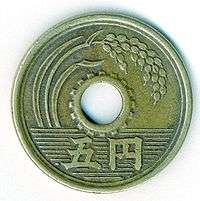A yen
A yen (A圓, A en) was a colloquial term used to refer to a form of military scrip used in post-war US-Occupied Japan, Korea, and Okinawa from September 7, 1945, to July 21, 1948. They are notable for being the first "Military Payment Certificates" (In Korea) given after World War II had ended.[1]
| A yen | |
|---|---|
| A yen (A円, A en) | |
| Denominations | |
| Plural | A yen |
| Symbol | ¥ |
| Banknotes | 10s, 50s, 1¥, 5¥, 10¥, 20¥, 100¥ |
| Demographics | |
| User(s) | Occupied Japan, Korea, and Ryukyu Islands |
| Issuance | |
| Central bank | • United States Civil Administration of the Ryukyu Islands • Provisional Government of the Republic of Korea • Bank of Japan |
This infobox shows the latest status before this currency was rendered obsolete. | |
History
Throughout its two-year history "A yen" scrip was issued in three different regions in seven denominations ranging from 10 sen to 100 yen. These "A" underprinted notes were used in Japan, Korea, and the Ryukyu Islands for only a little more than two months from July 19, 1946 to September 30, 1946.[2] Their usage was restricted to military forces as payment certificates rather than the civilian population which used "B Yen" scrip.[3] The only exception was in Korea where they were used as general currency from September 7, 1945 to July 10, 1946 before they too were restricted to military usage.[2] The "A yen" scrip was ultimately deprecated In all three regions on July 21, 1948 in favor of a one currency "B yen" scrip system.[3]
Production
All "A yen" series notes are considered scarcer than the "B yen" series, despite the former having millions more printed. Each note was printed under the A-A block expect for replacement notes which used block H-A.[2]
| Denomination | Amount printed | Ink color |
|---|---|---|
| 10 sen | 93,456,000 | Purple |
| 50 sen | 76,668,000 | Blue |
| 1 yen | 66,176,000 | Green |
| 5 yen | 29,840,000 | Blue |
| 10 yen | 51,880,000 | Green |
| 20 yen | 4,506,000 | Purple |
| 100 yen | 9,140,000 | Blue |
Collectability
Every denomination of the Japanese "A-yen" series is considered to be "scarce".[4] The large denomination bills of "20" and "100 yen" had been delivered in much smaller quantities than their "B" series counterparts.[2] Denominations with low print runs are generally harder to find than ones which circulated in greater amounts. In addition, the transition from civilian to military usage in Korea on July 10, 1946 made the "A" yen series worthless to civilians. Only a few high denomination notes were intentionally kept by civilians from redemption.[5] The "100 yen" banknote is now "elusive" when it comes to overall availability to collectors.[6] Booklets of specimen military yen currency also exist for the series, which include one of each denomination of "A" yen. The notes included are replacement H-A serial numbers with "SPECIMEN" roulette cancels.[1]
See also
References
- "Japan Allied Military Currency Supplemental A Specimen Book". Heritage Auctions. Retrieved April 7, 2020.
- George C. Baxley. ""B" and "A" Yen B&A型軍票 - B and A - Gata Gunpyō US Military Currency". www.baxleystamps.com. Retrieved March 9, 2020.
- Kadekawa, Manabu. Okinawa Champloo Encyclopedia (沖縄チャンプルー事典). Tokyo: Yama-Kei Publishers, 2001. p 176.
- The Numismatic Scrapbook Magazine. 23. Hewitt Brothers. 1957. p. 2376.
- C. Frederick Schwan (1995). World War II Remembered: History in Your Hands, a Numismatic Study. BNR Press.
- "Japan Allied Military Currency 100 Yen Series 100 Supplemental A Yen (1946)". Heritage Auctions. Retrieved April 7, 2020.
